In This Issue...
*
Fan Mail
*
F.I.D.O.: Kevin Slater
*
Dog Yard Noise
*
Road Food Inuit Dog Style
*
Differences in Mushing: Greenland and Arctic Canada, Part III
*
How Much is That Doggie in the Window?
*
Product Review: MAXIGUARD® Zn7™ Derm
*
IMHO: People, People, People
Navigating This
Site
Index of articles by subject
Index
of back issues by volume number
Search The
Fan Hitch
Articles
to download and print
Ordering
Ken MacRury's Thesis
Our
comprehensive list of resources
Talk
to The
Fan Hitch
The Fan
Hitch home page
ISDI
home page
Editor's/Publisher's Statement
Editor: Sue Hamilton
Webmaster: Mark Hamilton
The Fan Hitch welcomes your letters, stories, comments and suggestions. The editorial staff reserves the right to edit submissions used for publication.
Contents of The Fan Hitch are protected by international copyright laws. No photo, drawing or text may be reproduced in any form without written consent. Webmasters please note: written consent is necessary before linking this site to yours! Please forward requests to Sue Hamilton, 55 Town Line Rd., Harwinton, Connecticut 06791, USA or mail@thefanhitch.org.
This site is dedicated to the Inuit Dog as well as related Inuit culture and traditions. It is also home to The Fan Hitch, Journal of the Inuit Sled Dog.
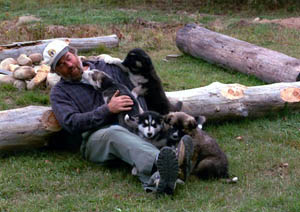
Kevin Slater and some of his Yukon Husky
pups
Photo: Slater
Kevin Slater
Mahoosuc Guide Service
Newry, Maine, U.S.A.
TFH: Tell us about
your background
with dogs.
KS: I always had dogs and to my parents' dismay,
sometimes too
many of them. I always had at least one and often
two to three dogs.
I always liked having dogs and working with them. The
first time I ever
got on the back of a dog sled was the winter of '82. I was
helping some
guy up in the interior of Alaska starting a guiding
business. So my introduction
and my interest have primarily been with freighting
expedition travel.
I've never raced. I really don't have any interest in
racing or working
with breeds of dogs that I perceive to be hyper. I knew
that first winter
that I was "hooked" and some day I was going to have my
own dog team.
That eventually came about in 1989. There was a fellow from Alaska down here in Maine and he had a motley collection of dogs and he was looking for a home for them. I had "sucker" written all over my forehead.
TFH: Were these
the kind of dogs
that you were interested in?
KS: No, they weren't at all. But when you live in
Maine, how
do you get freighting dogs, especially when the trend was
towards lighter
boned, no-coated, floppy-eared dogs for racing, not really
northern dogs.
I've always been interested in the more traditional dogs
of the North.
No matter what I do, whether it's building wood-canvas
canoes or timber
frame houses I tend to take a more traditional approach.
So I like the
traditional indigenous dogs that were bred for their
working qualities.
The dogs I adopted were a real mixed bag, but they were definitely bigger and stronger in terms of freighting. Most of them came from the interior of Alaska, bloodlines from the smaller Athabaskan villages, trap line dogs. The guy I got them from aspired to be a racer of some type but he definitely had dogs too big and too slow to be competitive. So they were probably going to be put down if someone didn't adopt them. There were some good dogs. There were seventeen in that group. I didn't want all of them so I convinced some friends of mine into adopting. I think we each ended up with roughly three five-dog teams. That was the beginning of my own dog team even though I don't think I now have any of the bloodlines of those original dogs because they really weren't what I was looking for. But they needed a home and I wanted to start a dog team. So we learned alot together. I gave them a good home and they got to do what they wanted to do, and I feel good about that. The first leader I ever had, Sitlik, was already a fairly well trained leader. She was probably eight or nine-years-old and beyond her prime. She was probably about seventy-five pounds (34 kg). She was leggy, a nice dog for what I was looking for. She was intelligent and as devoted as she could be given she'd been bounced around most of her life. That team was the nucleus for my first year.
Around 1990, Polly and I met. I also just happened to be given a dog at the same time from a woman I knew up on Indian Island. This was a dog from up north, I think either from one of the interior villages in Alaska or perhaps the Yukon Territory. Nikki was a big dog, probably eighty-five pounds (38 kg), which was very big for a female, leggy, good feet, black pads, a good coat, just exactly what I was looking for. Polly came to Maine with her dogs from the Yukon Territory. Some of their lineage went back to the very last RCMP team. The bloodline of quite a few of her dogs can be traced back to Old Crow, the northern-most Gwichi'in village. These were much more the kind of dogs I was interested in. That was sort of the real beginning for me. We bred Nikki a few times to some of Polly's males and the result was nice big dogs. The males were seventy-five to ninety-five pounds (34 to 43 kg) and rangy, just what I was looking for for pulling heavy loads in soft, deeper snow conditions. The leggier dogs have a real advantage in these conditions.
After we started building our own dog teams and doing some breedings, we weren't getting the time with our dogs, because we were working the traditional sorts of jobs, even though working for Outward Bound wouldn't be considered "traditional". I was a program director and there was office time. We wanted more time with our dogs and to be out with them so we said, "What the heck. Let's try to make a living at it. If twelve outfitters can survive in Ely, Minnesota which is in the middle of nowhere in terms of being close a population center, we should be able to do it here in Maine." And that's when we decided to chuck the jobs and start Mahoosuc Guide Service.
TFH: Are your dogs
the breed you
refer to as the Gwichi'in Dogs?
KS: Yes. But we call them Yukon Huskies now because
it's easier
for people to say and remember. As you know northern dogs
have specific
traits within certain geographic areas. Even within Inuit
Dogs I'm sure
you could find specific traits so that someone who really
knew the dogs
could probably look and say that a dog is from a certain
area.
TFH: I know the
issue of the British
Antarctic Survey dogs is a sensitive one for you,
but could you talk about
that a little? What was the reason for sending them
to Nunavik?
KS: I am sensitive about it, but you could pretty
much sum up
the British Antarctic Survey dog relocation effort as very
good intentions
with a very good initial plan. Depending on whose version
of the story
you listen to, there obviously was - for whatever reason
seems to be still
disputed - a massive extermination of the traditional
Inuit Sled Dog up
the eastern coast of Hudson Bay. So the breed did not
exist as a pure breed
any more and hasn't probably since the early
nineteen-sixties. Me, being
the idealistic person that I am, I thought, "Well, what a
better thing
to do with the last Canadian Inuit Dogs down in the
Antarctic than to return
them to the people they originally came from". I
have no doubts or
regrets about what we did. I only wish that I would have
had the foresight
to have built in more follow up provisions for the care,
treatment, et
cetera of the dogs once they did get back to Inukjuak We
naively thought
that once we got them back to Inukjuak they would probably
be bred. You
know, hindsight is always twenty-twenty. [Editor's
note: Most of the fourteen BAS dogs that were
relocated from Antarctica
to Nunavik in March/April 1994, as a result of the
treaty banning non-indigenous
species, died within a year after their
arrival. Three or four lived
another seven or eight years. According to Kevin,
there were no successful
breedings.]
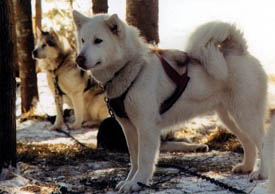
Ivalu (Geronimo x Misty), one of Kevin’s
last pure ISDs
Photo: Slater
TFH: When did you
get your Inuit
Dogs and how did you come to get them and why did
you decide to get them,
since you already had Yukon Huskies?
KS: I had been around and worked with natives that
had Inuit
Dogs and was familiar with the breed and I greatly admired
their working
qualities. There's probably not a tougher canine on the
planet, especially
if you measure it in terms of their ability to do amazing
amounts of hard
work in extremely cold conditions with little food.
There's no match for
them. I had a tremendous respect and appreciation for the
breed. After
an article or two in Mushing Magazine about the whole
British Antarctic
Survey relocation, some mushers from the interior of
Alaska, Peter Zimmerman
and Enrica Nadalini, who had some Canadian Inuit Dogs
contacted me and
said, "We happened to be having a litter and read with
great interest the
story in Mushing Magazine…"
Michael Wald in Fairbanks did either a skiing or snowshoe expedition in the Brooks Range with Geronimo and Misty, the parents of the pups that I got. He borrowed Geronimo and Misty from Peter and Enrica to do this expedition because he and his friend wanted additional freighting power. The dogs were pulling toboggans. Michael was impressed and couldn't praise the dogs enough, especially Geronimo. I trusted Michael's opinion and that's how I knew about their working qualities.
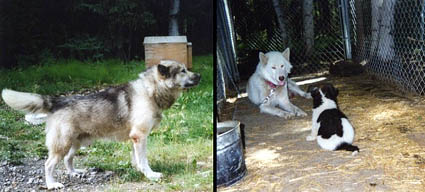
Geronimo, a GISD, and Misty, a CISD, and
a pup from their
litter Photo: Zimmerman
In 1994 Peter and Enrica sent three littermate pups, two males and a female, to me which, became my mostly Inuit Sled Dog team. When I got the pups I just put them in a pen loose with Hammish who had a fair bit of malamute in him and was similar in build to an Inuit Sled Dog. The pups basically grew up with Hammish. He was "Dad", their boss and their leader and I never had a lick of trouble. Those three Inuit Sled Dogs never got in a fight, never fought among themselves; well, I mean scraps, yes, but a serious fight they never had. The pups worked it out. They all knew their pecking order. It worked out well. It was a very strong and powerful four-dog team. I think I had that team for five years.
The primary reason I decided to not stay with the Inuit Dogs is that I don't think they are as "user friendly" for beginners. I did love those Inuit Dogs dearly. They were great dogs. We try to get out with our dogs for our own personal trips, but primarily our dogs are used for guiding. I think for guiding you need to have the temperament of dogs that if they get tied up in a knot in the gang line their first reaction won't be to bite the dog nearest to them, like Inuit Dogs would. When we're guiding, clients don't want to break up dogfights. I don't want my dogs fighting. Our dogs have to be very forgiving because our clients who are beginners at driving a dog team are going to make mistakes. That's why for guiding we need a breed of sled dog that's very beginner user friendly. Specifically the quality I look for in such dogs is that no matter what happens, they're not going to get ugly with each other. Like most of our dog teams, you couldn't get a fight even if you tried. I just felt that our own bloodlines were just more suitable. Polly's been working with the bloodlines of these dogs from the Yukon since 1979. So over the years we steadily reduced the amount of aggressiveness in the dogs.
TFH: You don't
have any more ISDs
in your dog yard, but you obviously still have an
appreciation for the
breed. Why is that?
KS: I think I mentioned already that you're not
going to find
a tougher dog, especially a dog that can work hard on a
small amount of
food under extremely adverse conditions. They're
survivors. They're amazingly
tough, spirited animals. If it was just me and my dog team
doing my own
expeditions I probably would end up getting back into
Inuit Sled Dogs.
There's no question I have a tremendous respect and
appreciation for the
breed.
TFH: You've guided
tours above
and below the treeline. Are different demands put on
the dogs by the two
environments?
KS: Definitely. Our dogs from the Yukon Territory,
where it
can get sixty below Fahrenheit (-51ºC), don't have as
thick and heavy
a coat as Inuit Dogs. Sure, our dogs might get by above
treeline for extended
periods but they would not be happy. The weather would
take its toll on
them. Conversely, when I had Inuit Dogs, I did a few
informal experiments
where, after a big snowfall - sixteen inches (40 cm) of
new snow on a packed
base - I mixed the team up. I put a couple of Inuit Dogs
next to a couple
of my bigger males like Guinness and Seámus. Seámus was
probably
thirty inches (76 cm) at the withers and a very leggy dog.
And in those
kinds of conditions it was just amazing. The leggy Yukon
Huskies could
keep a tight line, even in those conditions. It's like the
difference between
a deer and a moose trying to get through deep snow. The
longer legs are
definitely an advantage. But in terms of just raw torque
the Yukon Husky
probably doesn't have the torque that the shorter, more
compact Inuit Dog
has. But we're not running on sea ice with hard, wind
packed snow conditions.
We are primarily in the boreal forest in deep, soft snow.
I think for that
kind of pulling the leggier freight dogs have an
advantage.
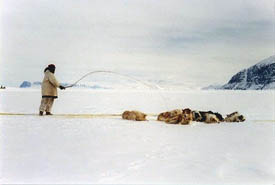
Pauloosie Koonaloosie settling his
team Photo:
Slater
TFH: How is the
arctic experience
different for your clients when done by dog team as
opposed to snowmachine?
KS: It's so much more of the history and the
culture. It's a
shame to see that there are fewer and fewer Inuit or
non-Inuit for that
matter who have dog teams for tourism-related purposes but
do not use the
dogs also for serious hunting and traveling. Right
now it looks like
a big percentage of Inuit Dog teams are going to be used
only when guiding
tourists. But they won't really be used for hunting and
traveling. [Ed:
For twelve years Mahoosuc Guide Service took clients
to Qikiqtarjuaq on
Baffin Island where they traveled with Pauloosie
Koonaloosie.]
In talking with Pauloosie he would reminisce, "You know,
when I had just
one dog team and I was hunting and traveling with them
that was the best
trained dog team I ever had." When he started guiding and
he had three
twelve- to fourteen-dog teams, it wasn't the same. Tourism
in the north
may be a viable way to help keep the population of Inuit
Sled Dogs up and
keep sled dogs being used, but the disconnect is - and
this is only my
opinion - if you have dogs you shouldn't use them just
whenever you're
doing a tour, even if you have them for that reason. The
dogs should be
worked and used pretty much year-round when the conditions
need and permit,
because there's a world of difference between keeping dogs
to give rides
to tourists as opposed to living, hunting and traveling
with your dogs.
There are some very good practical reasons to go by dog
team as opposed
to snowmachine. Although not all dogs have it, some can
sense bad or thin
ice conditions. Dogs often, can find the trails,
especially if you're trying
to get back to your camp or igloo in whiteout conditions.
Dogs often have
a better sense of direction than people. Dog teams don't
break down like
snowmachines do. And if you're in polar bear country, your
snowmachine
isn't going to alert you to that but the dogs will. There
are very good
practical reasons for not traveling in the north by
snowmachine.
TFH: It is well
known that you
have a very special connection with Inuit beyond
your relationship as an
outfitter working with guides when you take clients
above the tree line.
Why is it important to you that your clients
experience this, too?
KS: I have a strong personal interest in the
North. And I guess
that strong personal interest or connection with the North
and the native
people is sort of what led me to work with various Cree
and Inuit families
over the years to offer some guided trips. So for me I
would never even
consider offering trips or guiding in the North where
native people live
without working with them. It's their land, their country
so I wouldn't
even consider it any other way. And then the secondary
benefit for guided
trips is that I prefer to work not just with hiring a
guide, but we like
it when the whole family is into it, likes to be out on
the land in the
bush, when the guide's wife comes with him. We're not
doing this primarily
as a dog sled trip in the arctic. Sure that's part of it.
But an equally
big part of it is the whole cultural experience. And I
know that it's a
totally different experience when you include a guide plus
his wife and
the grandkids or one of their sons or daughters. That is
completely different
as opposed to when you have only one or two male guides
out there dragging
the tourists around just to show them the polar bears and
the seals. It's
a world apart. It's a much richer cultural experience.
And the other reason I'm sort of personally committed to working with natives in the north in developing cultural tourism is this. What other wage job option do natives have that actually reinforce traditional cultural values? They can drive a dog team, they can show tourists about hunting and teach traditional life and get a paycheck at the end of the day. The reality is they all live in homes, they all buy gas, they have bills to pay, too. Guiding and doing cultural tourism trips bridges the gap between the western wage economy and tradition Inuit culture. Most wage jobs in the North have nothing to do with traditional culture, if anything they help erode it.
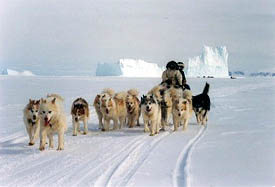
Pauloosie Koonaloosie’s team
Photo: Slater
TFH: When you take
clients above
the treeline, what do you hope your they learn from
their mushing experience
about the use of dogs in general and the Inuit Sled
Dog in particular?
KS: A lot of people aren't even aware that
there was and
is an indigenous breed of dog left alive. The Inuit Sled
Dog is the indigenous
dog of arctic North America and Greenland. A lot people
don't realize that.
They think blue-eyed Siberian Huskies are the sled dogs of
the North today.
So that's a big part of it. It was great when were able to
work with Pauloosie
because he could really capture the essence of the
closeness and importance
of the subsistence hunter and his dog team. It's harder to
convey now that
people grow up in villages, and not on the land as
subsistence hunters.
Those days when people were born in igloos and grew up in
a subsistence
hunting unit are gone. With some of these older hunters
and guides that
are still running dogs, it is possible to very clearly see
that connection
between man and dog, to see the importance of the dogs in
helping find
aglu (seal
breathing
holes in the ice), protecting the rest of the family from
nanuq when they're
out hunting. Inuit could not have done their circumpolar
migration from
Chukotka halfway around the globe without the Inuit
Dog.
TFH: Is there
anything else that
you want The Fan Hitch readers to know?
KS: Yes, there is. We were told by Allen Gordon of
Kujjuuaq
that the initial interest in the Inuit Sled Dog really
sort of spread at
the time of the return of the British Antarctic Survey
dogs. He said it
was part of the motivation to start talking about and
having Ivakkak,
the Nunavik dog sled race. So even though we weren't
successful breeding
or getting any litters of pups from them those Antarctica
dogs, it seems
like they were the real stimulus because it brought back a
lot of memories.
When we arrived in Inukjuak elders came down to meet us
and they were crying.
It was really moving! I know that it happened. So in
closing I still hold
on to the hope that there's going to be some greater good
that came from
the British Antarctic Survey dog relocation, that it seems
to have rekindled
a renewed interest in the pure Inuit Dog. There's Allen
Gordon and another
Inuk
musher
in Kangiqsualujjuaq who is also interested in having
purebred
dogs. I am optimistic that the rekindled enthusiasm will
continue to spread.
It would just be great if in my lifetime I can see a very
healthy, viable
population of Inuit Sled Dogs in Nunavik villages.
TFH: And Nunavut
too!
KS: Yes, but I say Nunavik because I had more
experience trying
to reintroduce them there. Nunavik doesn't have any or
darn few! For me
that would personally be very satisfying if in my lifetime
Inuit Sled Dogs
were once again in all those villages on the coast of
Hudson and Ungava
Bay.